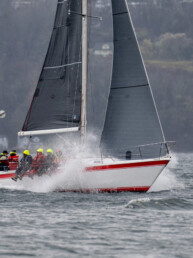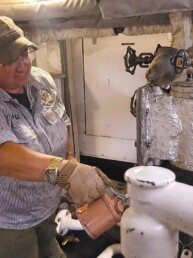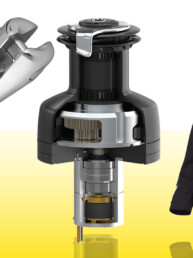This article was originally published in the March 2022 issue of 48° North.
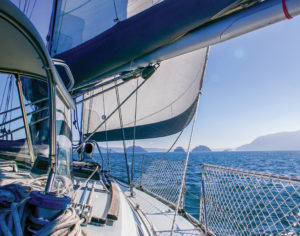 Every year, somewhere between a strong southerly wind blowing a hoolie through Puget Sound and daffodils pushing up through the ground outside the marina, there’s a collective sensation that hits every Pacific Northwest sailor: spring is almost here, which means summer cruising is ahead!
Every year, somewhere between a strong southerly wind blowing a hoolie through Puget Sound and daffodils pushing up through the ground outside the marina, there’s a collective sensation that hits every Pacific Northwest sailor: spring is almost here, which means summer cruising is ahead!
For our crew, new adventures on the horizon are always a welcome sight. But spring’s signals mean there’s work to do to get there. In Puget Sound, the San Juan Islands, British Columbia, and Alaska — at the dawn of each spring, our family has made numerous shifts in mentality, on-board routines, and preparation for summer sailing as the days start to get longer and warmer.
The feelings of excitement and promise brought on by the first signs of spring may be nearly universal among boaters, but certainly the specific versions of the associated shifts vary from person to person and pursuit to pursuit. Here’s how it goes for us.
The Mental Shift
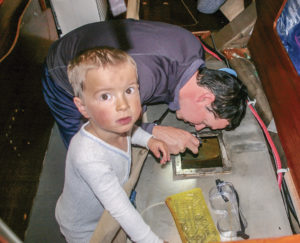
Shifting our frame of mind from winter to spring and then to summer is something we all experience. But for boaters, many of whom continue to sail all winter, when those first days of spring arrive and the sun breaks through the clouds, spirits soar. More boat owners filter down to the marina and the buzz of onboard activity ignites.
Lists of projects and parts abound, and the sound of pressure washers knocking off months of accumulated grit, grime, and green ring out. This is one of my favorite times to be part of the sailing community because optimism is high. We might get to see some of our sailing buds who haven’t come around in a while, and chatter about plans and possibilities is filled with excitement.
Along with the marina, we also see the transition happening in boatyards and chandleries throughout the Pacific Northwest. Travel lifts are busier, bottom paint is being applied, topsides are being shined, and brightwork is getting sanded and varnished. This flurry of work leads the next shift we make — the need to start seriously getting our boats and gear ready.
The Boat Shift
I’m a firm believer that thorough and thoughtful preparation is key to safe and fun sailing, especially when venturing far from available services. As such, there are innumerable things on a sailboat that need to be checked, serviced, or maintained before cutting the dock lines. I discussed this topic at length in the April 2021 issue of 48° North (see: Tips to Get Your Boat Out of its Winter Slumber) but one of the best places to start your boat prep is with your safety gear.
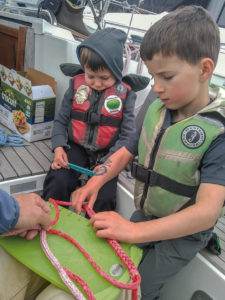
On Yahtzee we have a life raft and MOM8-A that have to be professionally serviced at regular intervals, and it’s always a good idea to have a look at gear like Life Slings and throw ropes for wear or chafe. Manual or automatic PFDs should be taken out, visually inspected, and then manually inflated and set out overnight to make sure they hold air. Down below, I check fire extinguishers, fire and CO2 alarms, and all manual and electric bilge pumps.
One thing to note is that USCG regulations on fire extinguishers are changing. Effective April 20, 2022, fire extinguisher bottles expire at 12 years from their date of manufacture. That date is stamped on the bottom of the bottle or near the UL label, so check yours and get new ones if needed.
From there, it’s the big picture of the boat’s systems. If you can, take a look at the condition of the water tanks and ensure there is no algae growth. Same for diesel tanks — which brings us to the engine. If needed, change the oil and fuel filters. Check zincs, the impeller, drive belt, coolant, and transmission fluid if applicable.
Moving on to the sails and rigging, go out sailing on a calm day. Not only will a spin around your local waters be helpful in making that mental shift, but you’ll also get a sense of what condition your sails and rigging are in. Do the sails need to be cleaned or repaired? Does any of the running rigging need to be replaced or re-run end-for-end? How does all the standing rigging look while under load? Depending on its age, you may request the expert eyes of a professional for some of this.
Something specific that Pacific Northwest boaters always think about if leaving their boats for a time in the winter is a dehumidifier and heater. As spring approaches, you won’t want to jettison your dehumidification plan for the season, but you might want to ensure you have space in your dockbox to stow that gear for an early season cruise or race.
No matter how much you do, though, your boat is never going to be perfect, and at some point it will be time to actually leave the dock. But where are you going…and when?
The Planning Shift

During the winter, mostly due to lack of daylight, boaters typically only venture out on the water for a few hours at a time. But as daylight grows, our plans open up for longer runs and more time spent sailing or exploring ashore. This is where one of my favorite parts of cruising comes in: route planning.
Just like most sailors, when I’m not on the water the next best thing is scheming to get back out there. There’s no better way to do that than to pore over charts and cruising guides, dreaming about where I might want to go next. I also love this part because it can be a social event. Picking the minds of fellow cruisers at one of the first dockside potlucks of the spring or meeting an experienced pal at a local watering hole to talk about routes can offer helpful tips or buoy confidence that my current cruising plan is on the right track.

Of course, a central consideration when planning is the trifecta of speed, time, and distance. And, whether you’re setting sail on a South Sound cruise or a voyage up the Inside Passage to Alaska, we all need the time to make these plans come to fruition. The problem with time is that we don’t have a lot of it to give these days, which can lead to an overly ambitious passage plan. Don’t make this mistake. Be realistic about how long you can be out for, how many hours per day you want to be underway, and how much time you want to allocate to activities ashore. Un-fun travel days can negatively affect even the most rewarding destination.
Do you want to be able to hang out in that sweet anchorage for multiple nights or are you hopping from one anchorage to another each day? The latter can get daunting, especially if the wind is light or you start to feel rushed. This is the part where you just need to get out there, take it a day at a time, assess the weather, and make it work as you go.
The Sailing Shift
You’re ready. The boat is prepared and the plan is in place. Now we shift to the mode that makes all that hard work worth it. It’s time to go. There’s nothing more rewarding than throwing the dock lines aboard, working your way out of the marina, and setting off for a weekend or a full summer of cruising.
Throughout our years cruising the Pacific Northwest, we’ve found both short and long cruises to be equally rewarding. That Fourth of July weekend rafted up with friends in Liberty Bay — glorious. The two-month cruise to the South Sound, swimming in warm water, and hiking leafy trails ashore — ultimate relaxation. Weaving through tall mountain peaks in British Columbia to reach the famed Princess Louisa Inlet — breathtaking. And taking the long route to Southeast Alaska to experience some of the most stunning cruising on the planet — utterly spectacular.
Wherever your cruising plans take you this year, enjoy shifting through all the stages to get there. The payoff is worth it!
Andy Cross
Andy Cross is the editor of 48° North. After years cruising the Pacific Northwest and Alaska with his family aboard their Grand Soleil 39, Yahtzee, they sailed south and are currently in the Caribbean Sea. You can follow their adventures at SailingYahtzee.com.

